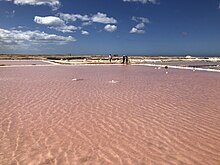
Back Salina AN ملاحات Arabic Солници Bulgarian Salina Catalan Saline German Αλυκή Greek Salejo Esperanto Salina Spanish Gatzaga (eguzki lurrunketa) Basque حوضچه تبخیر نمک Persian

A salt evaporation pond is a shallow artificial salt pan designed to extract salts from sea water or other brines. The salt pans are shallow and expansive, allowing sunlight to penetrate and reach the seawater. Natural salt pans are formed through geologic processes, where evaporating water leaves behind salt deposits. Some salt evaporation ponds are only slightly modified from their natural version, such as the ponds on Great Inagua in the Bahamas, or the ponds in Jasiira, a few kilometres south of Mogadishu, where seawater is trapped and left to evaporate in the sun.
During the process of salt winning, seawater or brine is fed into artificially created ponds from which water is drawn out by evaporation, allowing the salt to be subsequently harvested.[1]: 517 [2]
The ponds also provide a productive resting and feeding ground for many species of waterbirds, which may include endangered species.[3] However, Ghanaian fisheries scientist RoseEmma Mamaa Entsua-Mensah also noted that salt winning can destroy mangrove forests and mudflats, altering the environment and making it unproductive for other development or fish growth.[4] The ponds are commonly separated by levees. Salt evaporation ponds may also be called salterns, salt works or salt pans.
- ^ Davies-Vollum, K. Siân; Wes, Matthew (August 2015). "Shoreline Change and Sea Level Rise at the Muni-Pomadze Coastal Wetland (Ramsar Site), Ghana". Journal of Coastal Conservation. 19 (4). Heidelberg, Germany: Springer Science & Business Media: 515–525. doi:10.1007/s11852-015-0403-y. ISSN 1400-0350. JSTOR 24761156. OCLC 5889482841. Retrieved 27 February 2024.
- ^ Morrison, Philip (November 1978). "Books: The History of Salt, the Rise of the 'Chip' and How the Indians Lost Faith in Their Game". Scientific American. 239 (5). New York, New York: Scientific American, Inc.: 35–36. doi:10.1038/scientificamerican1178-35. ISSN 0036-8733. JSTOR 24955840. OCLC 9986402667. Retrieved 27 February 2024.
- ^ Athearn, Nicole D.; Takekawa, John Y.; and Shinn, Joel M. (2009) Avian response to early tidal salt marsh restoration at former commercial salt evaporation ponds in San Francisco Bay, California, USA, Natural Resources and Environmental Issues: Vol. 15, Article 14.
- ^ Ashon, Enimil (10 March 2017). "The Woman Who Saw Tomorrow". The Graphic. Accra, Ghana. Archived from the original on 25 February 2024. Retrieved 27 February 2024.